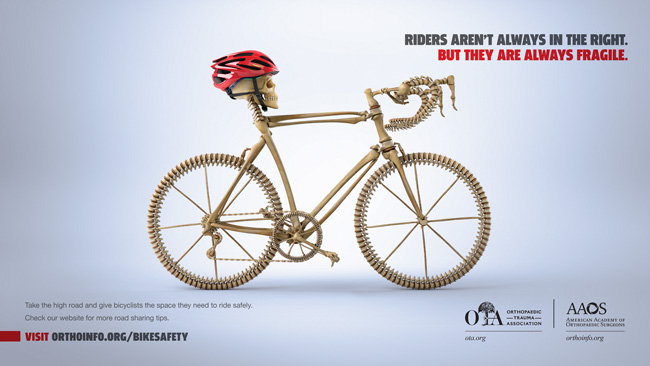It’s biking season all year long in Seattle but with the warmer and drier weather upon us, more and more bikes are on the road. Both cyclists and motorists have the responsibility to maximize safety. Bike riders are much more exposed than drivers so even when a rider does something boneheaded, remember – your broken headlight is much easier to fix than their broken bones. Take the high road, be patient, and give bicyclists the space they need to ride safely.
Some of the most common cycling injuries that orthopedic surgeons treat include broken collar bones, shoulder and elbow injuries, and broken wrists.
Courtesy of AAOS/OrthoInfo
Tips for Preventing Injuries To minimize your risk of injury while riding a bicycle:
Wear a helmet. Studies show that wearing a bike helmet reduces your risk of serious head and brain injury by 85%. Always wear a helmet approved by the American National Standards Institute.
Make sure the helmet fits snugly but comfortably, and does not obstruct your vision.It should have a chin strap and buckles that stay securely fastened.
Follow the rules of the road. Familiarize yourself with all of the bicycle rules of the road in your city or state. Ride in the direction of traffic. Follow traffic signs and lights. Signal your turns or your intentions so that drivers can anticipate your actions. If you are riding with others, ride single file if drivers are trying to pass.
Ride defensively. Understand that drivers often do not look for or see cyclists, so you must be fully aware of your surroundings and ready to act to avoid a collision. Intersections are especially dangerous because drivers making turns are not necessarily looking for cyclists. Be careful when riding next to parked cars to avoid being hit by an opening door.
Choose bike routes wisely. Avoid riding on high traffic roads. The most direct route to your destination is often not the safest because more vehicles will also take that route. Select streets with fewer and slower cars. Whenever possible, choose streets with designated bicycle lanes. If there is not a bicycle lane, ride on the right shoulder of the road. Choose wide streets. When a street lane is too narrow for a vehicle and bicycle to safely ride side-by-side, or if there are several parked cars on the street, you will need to join traffic and ride toward the center of the road. If this causes traffic behind you to jam, or if cars are switching lanes trying to pass you, it is safest to find a different, quieter street.
Avoid distracted cycling. Do not listen to loud music with head phones, talk on your phone, text, or do anything else that can obstruct your hearing and/or vision while riding.
Take extra precautions while bicycling at night. Be seen to avoid being hit. Wear bright fluorescent colors and make sure to have rear reflectors. Both a working tail light and headlight should be visible from 500 feet away.
No drugs or alcohol. Never ride a bicycle while under the influence of drugs or alcohol.
Never underestimate road conditions. Be cautious of uneven or slippery surfaces.
Maintain your bicycle. Check your bicycle’s mechanical components on a regular basis (brakes, tires, gears, etc.), just like you would for a car. If your bike is not in good condition, do not ride it.
Adjust your bicycle to fit. Make certain the bicycle is the proper size for the rider. Appropriately sized frames, handlebar and seat heights will improve your ability to control the bike, and reduce the risk for overuse injuries. If you ride regularly, consider a professional fit from a bike shop.
Dress appropriately. Avoid loose clothing and wear appropriate footwear. Never wear flip flops. Wear padded gloves. Use appropriately padded cycling shorts for longer rides. Wear sunscreen. If you commute on your bike, carry your belongings in a bag with close fitting straps.
Pace yourself. Cycling can be vigorous exercise. Make sure you are fit enough to participate before you start pedaling. In addition, make sure you understand how to use the gear systems on your bike to help control your physical exertion level. See your doctor before you begin any exercise program.
Change riding positions. Slight variations in your position can reduce stress on pressure points on your body and avoid over stressing muscles.
Hydrate. Be
sure to carry water and food on longer rides. Drink a full water bottle each hour you spend on the bike.
Supervise younger riders at all times. It is recommended that younger children ride only in enclosed areas — away from moving vehicles and traffic
-Sara Jurek, M.D.
To see her personal page, click here.

